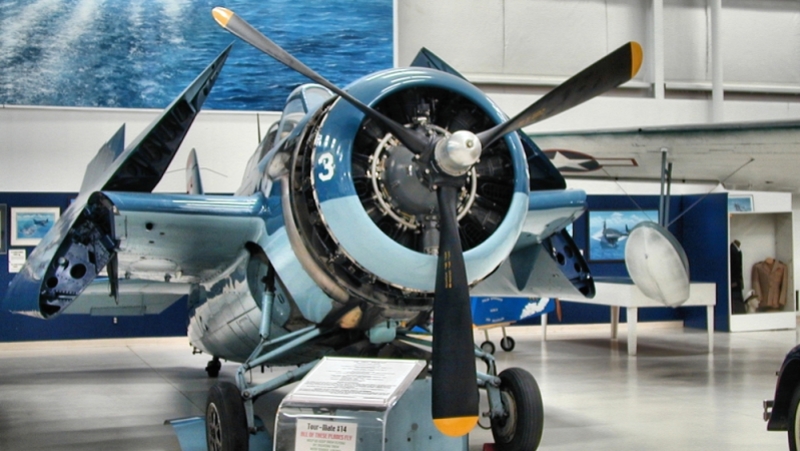 | ||||
 | ||||

| ||||
Palm Springs Air Museum, Palm Springs, CA (511/2002) | ||||
|---|---|---|---|---|
 |
 |
 |
 |
 |
8 March 1910 (England): Claude Moore-Brabazon receives the Royal Aero Club’s first aviator’s certificate in London. Charles Rolls receives the second. 8 March 1910 (France): Elise Deroche, the colorful self-styled Baroness Raymonde de Laroche, becomes the first woman in the world to receive a pilot’s license in Paris. 8 March 1917 (Germany): Count Ferdinand von Zeppelin, inventor of the practical dirigible, dies. 8 March 1923 (USA): Lieut. Frank W. Seifert, USAS, Rockwell Field, San Diego, California, with Russell M. Otis (meteorologist) reach an altitude of 19,000 feet in a De Havilland DH-4B while taking lunar radiation observations. 8 March 1923 (USA): Lawrence B. Sperry in a Sperry Messenger aircraft makes contact with an Army DH biplane over Mitchell Field, New York. 8 March 1929 (USA): The 1928 Harmon Trophy is presented to Lieut. Carl B. Eielson for his 1928 flight with Wilkins over the North Pole. 8 March 1937 (Spain): A Nationalist offensive begins against Guadalajara, Spain, with support by Italian forces, including 50 fighters and 12 reconnaissance planes. 8 March 1942 (Germany): Overnight, Royal Air Force Bomber Command bombs Essen, Germany, on three consecutive nights with 211, 187, and 126 aircraft respectively, losing a combined total of 16 bombers. The raids are the combat debut of the Gee navigation aid, raising British hopes that precision bombing of the Krupp armaments factory will be achieved, but it is not hit, and bombs in fact do far more damage to neighboring towns than to Essen itself. The third raid includes two Avro Lancasters, the first use of the Lancaster against a German target. 8 March 1946 (USA): The Bell 47, a two-bladed, single engine, light helicopter manufactured by Bell Helicopter becomes the first helicopter certified for civilian use on 8 March 1946. More than 5,600 Bell 47 aircraft were produced, including those produced under license by Agusta in Italy, Kawasaki Heavy Industries in Japan, and Westland Aircraft in the United Kingdom. The Bell 47J Ranger is a modified version with a fully enclosed cabin and fuselage. 8 March 1949 (Hawaii/New Jersey): Nonstop flight of 56 hours and 2 min has put captain William Odom in the record books. Leaving Honolulu, Hawaii, he covers a distance of 4,957.25 miles before landing at Teterboro, New Jersey to gain the world record in Class C-1-c for light aircraft. 8 March 1951 (Canada): A certificate of airworthiness is granted to the first Canadian-designed and built helicopter, the Sznyler SG-VI Grey Gull, at Dorval, QC. 8 March 1954 (USA): First flight of the Sikorsky H-34 Choctaw. The Sikorsky H-34 Choctaw (S-58) was a piston-engined military helicopter originally designed by American aircraft manufacturer Sikorsky for the United States Navy for service in the anti-submarine warfare (ASW) role. 8 March 1955 (USA): The first unit of Republic F-84F Thunderstreak fighter/bombers capable of being launched and recovered by Consolidated Vultee B-36 Peacemakers was formed. 25 Republic RF-84F Thunderflash aircraft were converted to GRF-84F to be carried, and launched from the bomb bay of a GRB-36F bomber as part of the FICON project. The aircraft were later redesignated RF-84K. 8 March 1957 (USA): The Grumman F11F-1 Tiger, the world’s first carrier-based supersonic fighter, enters service with United States Navy Attack Squadron 156 (VA-156). 8 March 1962 (Turkey): The 1962 Turkish Airlines Taurus Mountains crash occurred on 8 March 1962 at 17:43 local time (15:43 UTC) when a Turkish Airlines Fairchild F-27 airliner (TC-KOP), on a scheduled domestic flight from Esenboǧa Airport (ESB/LTAC) in Ankara to Adana Airport (ADA/LTAF), flew into the Bolkar Mountains on approach to landing. The aircraft had three crew and eight passengers on board. All crew and passengers lost their lives at the crash. 8 March 1973 (USA): A Douglas EC-47 Skytrain carrying members of the US Army Golden Knights parachute team on a recruiting tour crashes and explodes at ~0900 hrs. in a muddy cornfield on the Basil Perry farm near Silk Hope, North Carolina while en route to their first performance of the season, at Overland Park, Kansas, killing 11 team members, two flight crew and the crew chief. The flight had departed Fort Bragg, North Carolina, at 0808 hrs. Cause was found to be overloading caused by the installation of a heavy metal plate floor, installed in Vietnam, but not entered in the logbook. 8 March 1974 (France): The Charles de Gaulle Airport at Roissy-en-France is officially opened. The new international airport is located 15.5 miles (25 km) from the center of Paris. 8 March 1988 (USA): Two Sikorsky UH-60 Blackhawk helicopters from Fort Campbell, Kentucky, collided on a night training mission. They were flying at 92 mph air speed and about 250 feet from the ground when they collided a Fort Campbell. The Army identified three of the dead as Staff Sgt. Charles L. Shirley, 21, of Arkansas; Sgt. Dennis Sabot, 28, of Iowa; and Spec. 4 Samuel A. Hintz, 23, of Ohio, all from the 2nd Battalion, 502nd Infantry. A total of 17 soldiers were killed in the crash. 8 March 2001 (USA): Launch of Space Shuttle Discovery STS-102 at 06:42 EST. Mission highlights: ISS assembly flight 5A: Destiny lab. 8 March 2002 (Arabian Sea): A Grumman F-14A Tomcat (BuNo 158618) of VF-211, based at NAS Oceana, Virginia Beach, Virginia crashes into the Arabian Sea after a failed attempt to land on the carrier USS John C. Stennis. The Navy said both crew members were pulled from the water by a rescue helicopter shortly after the accident. Neither appeared to be seriously injured. 8 March 2002 (Portugal): A Portuguese Air Force 201 Squadron General Dynamics F-16 Fighting Falcon crashes in Monte Real while landing, killing the pilot. |
||||
| ** The Skytamer Ready Room (Guestbook) ** | ||||
 | ||||